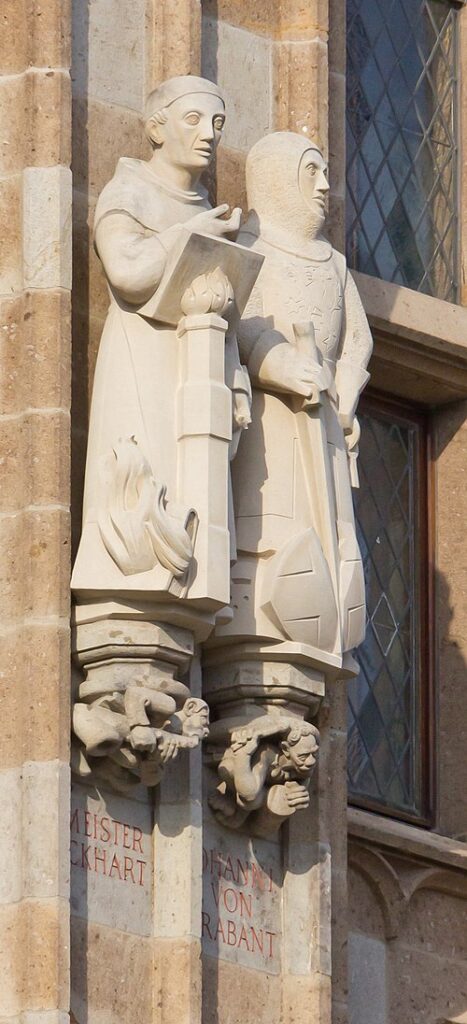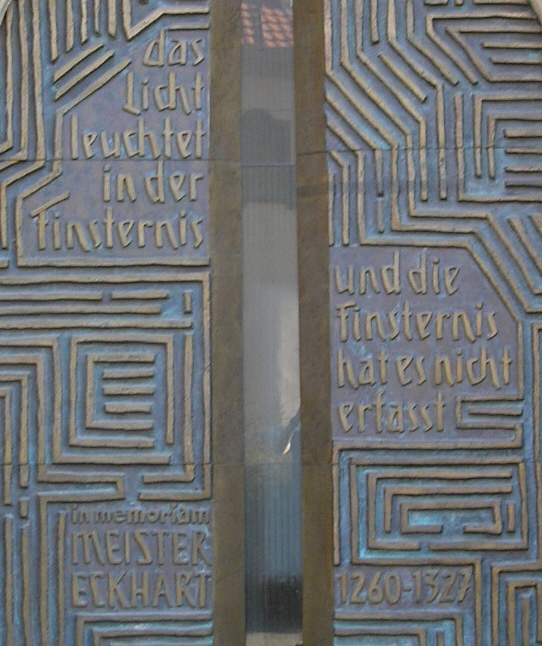
“Of particular concern to me in my Eckhart interpretation is the following: In the texts of the German sermons, I have identified two doctrines, the doctrine based on the motif of ‘birth’ where ‘God (the Father) gives birth to his single Son in the soul’, and the doctrine based on the motif of ‘breakthrough’ where ‘the soul breaks through (durchbrechen) God and penetrates into the nothingness of the Godhead’. In the ‘birth’ motif, there is an exhaustive passivity of the soul, while in the ‘breakthrough’ motif, there is intense activity. To express the contrast, the ‘birth’ motif is about ‘accepting God’ and the ‘breakthrough’ motif is about abandoning God” (Ueda Shizuteru).
As the only Christian mystic to have postulated an empty godhead above God-as-creator, Meister Eckhart was bound to attract the attention of Kyoto School thinkers starting with Nishida, then Nishitani, and finally Ueda, who spent three years studying his thought in Germany. Nishitani had given lectures on Eckhart during his period of study with Heidegger in Freiburg from 1937 to 1939. Ueda went further and, as Davis tells us, he “abruptly halted his study of [Sanskrit and Tibetan languages]” in order to study Meister Eckhart, “which required him to learn Middle High German as well as Latin.” He then left for Marburg University in Germany to study Eckhart’s sermons. His dissertation on Meister Eckhart … was published in 1963 under the title Die Gottesgeburt in der Seele und der Durchbruch zur Gottheit: Die Mystische Anthropologie Meister Eckharts und Ihre Konfrontation mit der Mystik des Zen-Buddhismus.”

at Town Hall Tower, Cologne
In his review of Ueda’s dissertation, Tsujimura Koichi note that while the title of the treatise – which translates as “‘The Birth of God in the Soul and the Breakthrough to the Godhead’ clearly highlights its subject matter and its structure, the subtitle of the treatise ‘Meister Eckhart’s Mystical Anthropology and Its Confrontation with Zen Buddhism’, which was apparently not chosen by the author himself, … appears inappropriate, as it exposes the utterly serious matter of the unum necessarium to misunderstandings by associating with and rendering fashionable the terms ‘mysticism’, ‘anthropology’, and ‘confrontation’.”
Here is how Ueda himself presents his encounter with Eckhart’s theology in “My Philosophy”: “I was deeply amazed at the fact that Eckhart’s texts were full of expressions that sounded like Zen language or literal translations [of Zen texts into Eckhart’s] … Of particular concern to me in my Eckhart interpretation is the following: In the texts of the German sermons, I have identified two doctrines, the doctrine based on the motif of ‘birth’ where ‘God (the Father) gives birth to his single Son in the soul’, and the doctrine based on the motif of ‘breakthrough’ where ‘The soul breaks through (durchbrechen) God and penetrates into the nothingness of the Godhead’. In the ‘birth’ motif, there is an exhaustive passivity of the soul, while in the ‘breakthrough’ motif, there is intense activity. To express the contrast, the ‘birth’ motif is about ‘accepting God’ and the ‘breakthrough’ motif is about abandoning God’. While ‘the being one’ of the soul and God is explained in the ‘birth’ motif by the trinitarian language as a divine life in which God the Father is in communion with God the Son, in the breakthrough motif, i.e., ‘neither Father nor Son’, the “one” is explained by the formless condition of the one in its oneness. The doctrine associated with the ‘birth’ motif is mostly in line with the tradition of Christian mysticism, but regarding the doctrine associated with the ‘breakthrough’ motif, these have a distance from the self-understanding of Christianity as expressed in its doctrine and theological framework. Thus, it is clear that these two kinds of doctrine differ in nature. Given the fact that these two motifs appear repeatedly next to each other or conjoined in the sermon texts, while their relationship remains opaque, I thought that the study of the relationship of the two motifs forms a basis for interpreting Eckhart’s fundamental thought. Now, a great deal of scholarly literature on Eckhart that I could make use of at that time, these [two motifs] were hardly seen as two different doctrines, and furthermore, I was surprised that many Eckhart interpretations included almost no mention of the words where Eckhart invokes the realm I see as the ‘breakthrough’ motif … One must say that during the 1960s the interpretations of Eckhart were oriented, explicitly or implicitly, to the so-called problem of ‘heresy’.”
Tsujimura notes that Ueda’s insight was most probably influenced by an article written by Nishitani entitled “The Relationship between God and the Human in Meister Eckhart’s Works” (1948). But it was also based on Ueda’s own experience of Zen which made it possible for him to resonate with Eckhart’s mystical experience. He says: “Only the same recognizes the same.” And this is what Professor Ernst Benz, the supervisor of Ueda’s dissertation in Marburg, found particularly significant in his study. Furthermore it was a mystical experience that belonged to a non-Christian spirituality. Another aspect of Ueda’s study Benz valued is that, in contrast to an earlier treatise written by D.T. Suzuki about Eckhart, “Ueda refrains from quickly identifying Eckhart with Zen and instead highlights their differences. We greatly welcome this benevolent adequate appraisal.”
Tsujimura explains that, according to Ueda, Eckhart’s “powerful experience – God and I, we are one,” had led him to ask: “How does God need to be constituted in order to be one with the soul? How does the soul need to be constituted in order to be one with God? And Eckhart’s answer had been the “birth” and the “breakthrough” motifs, which he analyses as follows:
“The first means: ‘God gives birth to his son in the soul and therewith gives birth to the soul as his son’. The second means: ‘The soul penetrates to the ground of God and there comprehends how God is in himself and one with himself.’ Through the first motif, Eckhart speaks about the unification of the soul with God, while through the second, he speaks about the ground of the soul and the ground of God being one. The first motif addresses the father-son relationship between God and the soul, while the second addresses a relationship utterly stripped of any figurative quality. The first depends on the absolute passivity of the soul, while the second depends on its radical activity. With the first motif, Eckhart says: ‘I am the Son of God’, with the second, he says: ‘I am neither God nor creature’.”
In other words, in the birth motif, the soul unites with God, traditionally conceived as “creator,” and in the breakthrough motif, the ground of his soul becomes one with the godhead, i.e., nothingness, where it shares the ground of God. Properly understood, during the mystical experience “one is neither God nor creature”, and the accusation of heresy, which stated that one could “be” God, does not hold. The ontological gap between God and his creature is respected.
At this point,Tsujimura brings up a similar approach in the concept of kaji (grace) in Shingon Buddhism which makes it possible for practitioners to resonate with Dainichi (Mahavairocana, standing for the dharmakaya, as the ultimate reality of emptiness), to bridge what in Christianity is referred to as the ontological gap. In John Krummel’s words: “On the basis of kaji, the three mysteries of the hosshin (Skt dharmakaya) and the three corresponding forms of activities of sentient beings inter-permeate. That is, our own bodily, verbal, and mental activities are already expressions of the three mysteries of the hosshin. This inter-permeation is hence ‘always already’, and yet what is lacking for the most part is our awareness of it that would realize it. That is why Kukai, following the Dainichikyo, prescribes the ritual practice of bodily acts, verbal acts, and mental acts. In Tsujimura’s words, it is “like we instal an app into a computer to allow it to read internet documents.”
Having differentiated Eckhart’s sermons along the lines of the birth motif, i.e., the unification of the soul with God”- and the breakthrough motif, i.e., the soul taking leave of itself once it is unified with God -, Ueda was faced with the problem of having to show how they related to each other. He writes: “Concerning their relationship or rather the leap from the former to the latter,” Ueda continues, “if Eckhart thus speaks of the breakthrough motif, then his explanation of this motif is not only a paraphrase of the ‘birth of God in the soul,’ but more. (1) The motif essentially depends on the activity the soul (‘I break through God’). (2) It is the achievement of perfect purity and transparency of God and the soul, are still thinly veiled in ‘the birth of God in the soul’ based on the figurative quality inherent in the relationship between father and son.” In other words, the ‘breakthrough’ is the explicit continuation of ‘the birth of God in the soul’. The former is a coming-into-expression of the latter, whose coming-into-expression the continuation consists in. Speaking with Eckhart, it means a continuation of said unification towards being-one in a transparent manner, which precisely represents the ground and essence of that unification. Perhaps you could say: it means that this unification (unio) is broken by the transparent presence of its own essence (unum), which is hidden from itself.”
In Buddhist terms, I see the purification process at work in the “birth of God in the soul” as the Buddhist practice of self-emptying aimed at removing the screen of attachments that keeps our Buddha-nature from becoming actualised. It involves a “letting go” – what Kosho Uchiyama calls “opening the hand of thought” – that can be regarded as a passive approach to reality. But it is the more active approach of the Great Doubt leading to the Great Death, or, in Soto Zen, the intensive practice of shikantaza (just sitting) that triggers the Great Awakening, and corresponds to the “breakthrough” which is the continuation of the actualisation of our Buddha-nature.
Tsujimura uses the Zen “Ox-Herding” pictures to translate Eckhart’s insight into Buddhist terminology. The ten pictures feature a young man searching for an ox (or a bull) – obviously a metaphor for his true self. Tsujimura says that “‘the birth of God in the soul’, and the ‘breakthrough’ approximately correspond to the third stage: ‘Perceiving the Bull’, and the eighth stage: ‘Double Forgetting of the Herder and the Bull’ respectively.” The eighth stage is represented by a big circle standing for the negation of the duality between the man and the bull. Tsujimura says: “Roughly put, the former is similar to passing a school entry exam, while the latter equates to passing a graduation exam. With the exception that the graduation exam exactly represents the essential beginning of a true human’s life.”
What Buddhism refers to as the “true self” is for Eckhart the “true human” who “holds within himself the ultimately essential character of Godly unification. ”In the famous sermon on Maria and Martha, Ueda “takes one step further in ‘taking leave of God’, meaning [proceeding] one step further beyond a transparent state of being-one, without losing either transparency or the state itself.” Ueda writes: “Taking leave of God thus extends in two directions, while simultaneously being one single act of taking leave of God. The first direction signifies the return of the soul to its primordial ground, where it has always been and always is; the second signifies the return of the human to the reality of the world, where it has always been and always is. Both happen in one single return. ‘On the one hand, the soul resides somewhere beyond the afterworld, above God in the Godhead; on the other hand, it resides on this side of this life, as it appears within the human at the stove or in the barn.” Tsujimura comments: “Such a human is ‘a common human among humans and simultaneously not human anymore. Such a human is ‘a true human’ whose amorphous appearance Ueda perceives in the afore-mentioned sermon ‘Martha’.”
Eckhart inverts the traditional theology where Maria, who spends her whole life in prayer, is regarded as closer to God than Martha, who still attends to her daily duties, when he states that, in Tsujimura’s words “Martha is not anxious anymore about the One as such, ‘because she is one with God himself under any circumstances. Only now she is capable of calmly tending to many things in the reality of the world without being prevented from being One with God by doing so. From such a capability wells an infinite and endless ‘working without why’,” meaning the ‘vita activa’. In this regard, Ueda writes: “Thus, with Eckhart, the ‘via activa’ signifies the ‘vita’ away from God towards the reality of the world, which is one and the same as ‘towards the Godhead by passing through God. ”Like Eckhart, Ueda says: “the fact that Jesus called Martha by her name twice is an indication of her double perfection, namely her perfection through her temporal work and her eternal perfection in eternal bliss. In other words, it is an indication of her having completed that one single return in the above-mentioned directions. This is why Christ says to Martha: ‘You are troubled about many things’. Only after such completion, true care [Sorge] and multiplicity [Vielheit] emerge. This is because Martha already possesses the ‘unum necessarium’, meaning the capacity of being-one with God.”
This, however, is not the end of the story. In “My Philosophy,” Ueda, back in Japan, tells us: “When my Marburg dissertation was published as a book, the situation changed anew. Professor E. Benz, an editor of the Latin Sermons in the Complete Works of Eckhart and one of my dissertation examiners at that time, suggested that I add an extra chapter on ‘Eckhart and Zen’ as an appendix … In response, I wrote that new chapter … and sent it to Germany where my book was published in 1965 including the appended chapter. This chapter became the base of what was later released in Japanese as ‘Zen and Mysticism’ (now in Ueda’s Collection, Vol 8, Non-Mysticism – Eckhart and Zen).” Although Ueda had practiced Zen for three years before going to Marburg, it is only at this point, now in possession of an in-depth understanding of Eckhart’s Christian brand of mysticism that he started to write about Zen. “Eckhart and Zen” provoked comments from readers, in particular with regards to Ueda’s emphasis on the breakthrough motif, which, they said, was the result of a “Zennish” interpretation. “In this development, “Ueda writes, ”’Eckhart and Zen’ is not [merely] an appendix but gradually, as provoked by comments on my works from Eckhart researchers it became one of my fundamental challenges.” In particular, it led to Ueda’s working out of the notion of non-mysticism which, he says, “became for me over the course of more than thirty years a decisive term of utmost significance.“
For details on Ueda’s characterisation of “non-mysticism,” please go to
https://buddhism-thewayofemptiness.blog.nomagic.uk/non-mysticism/
Sources:
Tsujimura Koichi’s review of “Ueda’s Marburg dissertation,” Bret W. Davis – “The Contours of Ueda Shizuteru’s Philosophy of Zen,” and Ueda Shizuteru – “My Philosophy” in Tetsugaku Companion to Ueda Shizuteru, Ed. Ralf Müller, Raquel Bouso and Adam Loughnane
Bret W. Davis – “Letting Go of God for Nothing – Ueda Shizuteru’s Non-Mysticism and the Question of Ethics in Zen Buddhism,” in Frontiers of Japanese Philosophy Vol 2.
John W. M. Krummel – entry on Kukai in the online Standford Encyclopedia of Philosophy

